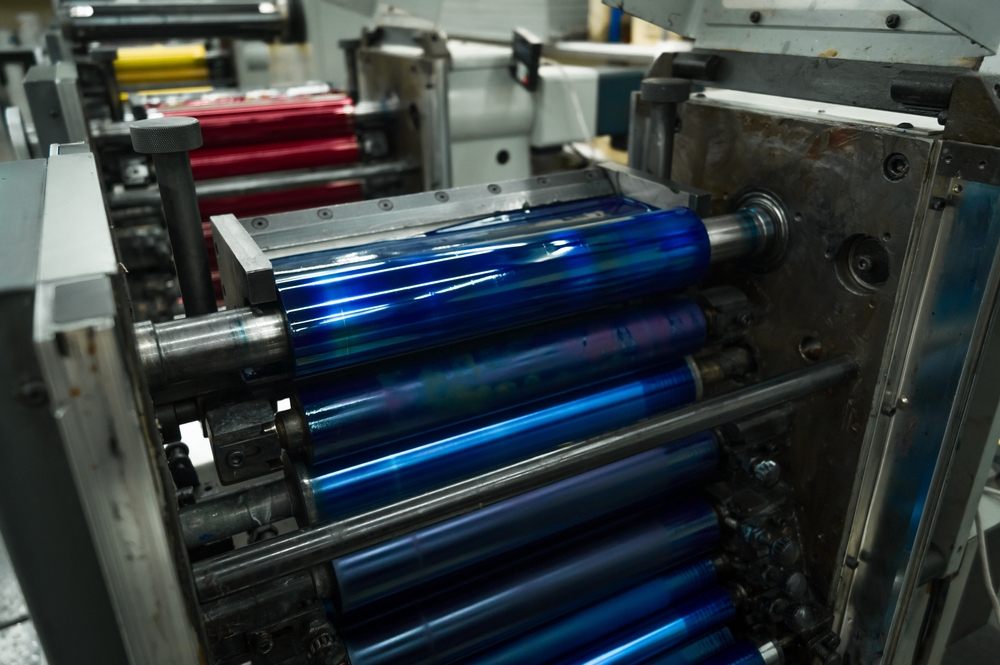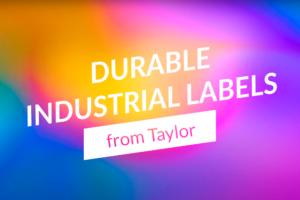Flexography is a printing technique widely used across various industries due to its versatility, efficiency, and ability to work with different materials. Over time, it has become one of the most popular techniques for the production of labels, packaging and other large-scale printed products, especially in industrial label production.
Its speed, competitive cost and adaptability make it an ideal choice to meet the needs and standards of modern industry. In this article we will explore flexography, its applications, the industries in which it’s mostly used and its main benefits.
What is flexography?
Flexography is a relief printing system that uses flexible rubber sheets to transfer ink onto various types of substrates. It functions through fast-drying, high-adhesion ink, making it ideal for printing on diverse materials such as plastic, cardboard, paper and adhesive labels, among others.
Unlike other printing methods, like offset printing or screen printing, flexography is able to adapt to non-porous surfaces while ensuring a fast production. This makes it a highly cost-effective option for medium and large print runs. Additionally, its flexibility enables a faster printing on materials of different textures and thicknesses, ensuring durable and visually appealing results.
What is flexography used for?
This printing technique is primarily used in label and packaging production. Due to its versatility, it is commonly used in the manufacturing of:
- Adhesive labels for various mass-consumption products
- Flexible packaging for food, cosmetics and pharmaceuticals
- High quality printed cardboard packaging
- Customized plastic and paper bags
- Newspapers and magazines in publishing industries
- Promotional material, such as brochures, posters, flyers and displays
- Wrappings and other decorative elements for exclusive products
Since it’s an adaptable printing method, flexography plays a crucial role in the labeling industry, allowing the making of products with presentations that are as visually appealing as they are functional. In addition to this, its ability to work with different substrates makes it an ideal option for industrial sectors with specific printing needs.
Which industries is flexography used in?
Flexography has become an essential printing technology for many industries, including:
- Food industry: moisture-resistant packaging and labels containing nutrition information and product details for snacks, cookies, bread, frozen goods, and more, as well as packaging for everyday consumer products.
- Pharmaceutical industry: packaging, labels, and medical prospectuses that ensure the clarity of the product information and withstand storage and distribution conditions without losing legibility.
- Cosmetics industry: packaging and adhesive labels with glossy, metallic and other custom finishes that help brands stand out among their competitors.
- Automotive industry: technical and safety labels to maintain critical information readable and durable, despite being exposed to external factors such as moisture, heat and friction.
- Retail and logistics industry: barcodes, price tags, and packaging materials in large quantities for a faster, higher quality production.
- Packaging industry: clear and sharp graphics on materials like cardboard, plastic and paper for packaging in various sectors.
Benefits of flexography
The popularity of flexography reflects its numerous benefits. The following can be found among them:
- Fast production to print larger runs in less time
- Compatibility with a wide range of materials, such as plastic, paper, cardboard, labels, and more
- Fast-drying ink that reduces waiting times and increases efficiency
- Cost-effectiveness for large scale production
- Customization availability to print in different colors and finishes
- High precision when printing fine details and vibrant colors on different materials
- Versatile applications that adapt to several industries
Cutting edge flexography technology at Taylor Mexico

At Taylor, we are driven by a commitment to innovation and excellence in every aspect of our printing processes. Leveraging advanced flexographic technology, we deliver high-quality, efficient, and customized solutions designed to meet the unique needs of our clients.
Our flexographic printing solutions are engineered to reduce waste, accelerate production times, and deliver sharp, consistent, and durable results. We operate under the highest quality standards and proudly hold certifications such as ISO 9001:2015, IATF 16949, ISO 14001:2015, SGS, and WCA. We also comply with key industry regulations, including UL, ANSI, and CSA. We serve critical sectors such as HVAC, electrical, electronics, and automotive, providing industrial labels that meet the most stringent performance and regulatory requirements.
To remain at the forefront of the industry and respond to increasing market demand, we are investing approximately $5 million dollars in 2025 to enhance our flexography division—expanding our production capacity and reinforcing our dedication to quality and innovation.If you’re looking for flexographic printing solutions that meet the highest industry standards, Taylor is the partner you can trust. Contact us, and let’s bring your next project to life!



